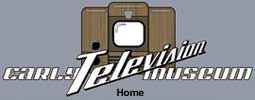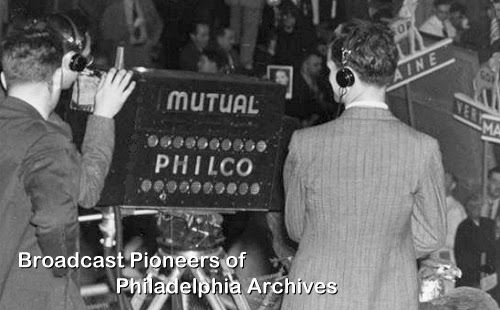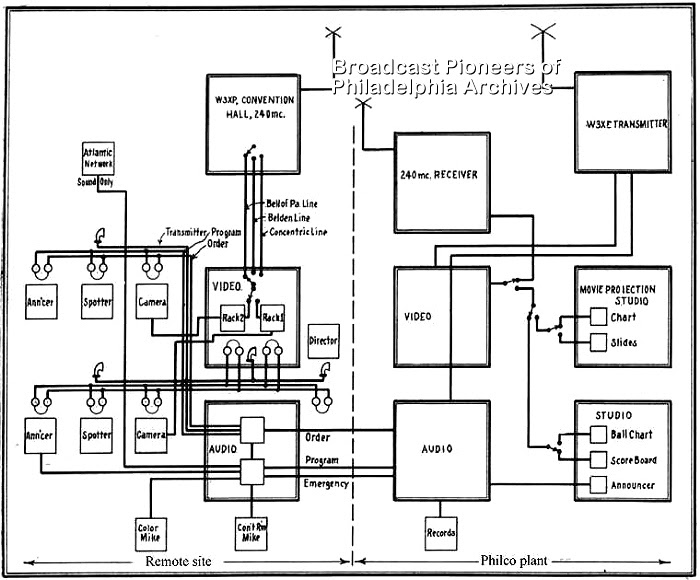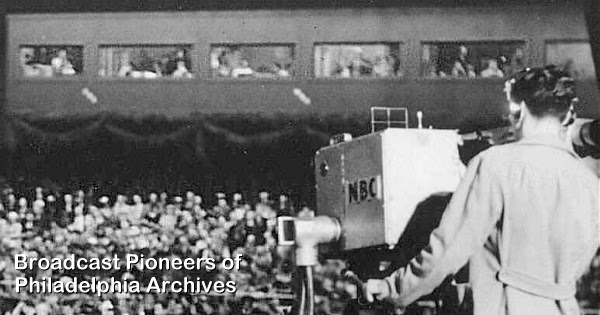Early Electronic Television 1940 Republican ConventionFrom the Broadcast Pioneers of Philadelphia July 2016 NewsletterCourtesy of Steve Dichter Did you know... the first television coverage of a US political convention was right here in Philadelphia in 1940. Local coverage on W3XE (now KYW-TV) and "network coverage" on a few stations from NBC. Initially, it was believed that NBC and Philco coverage were the same with local Channel 3 (owned by Philco) carrying almost twice the hours as the network. However, we now are convinced that the NBC and Philco telecasts were not related at all. They were totally separate feeds. We do know that in the July 1, 1940 issue of Broadcasting Magazine, an article said: "Television audiences for the first time in history viewed a national political convention on their receivers when NBC and Philco sent television crews and equipment to the Republican National Convention in Philadelphia."
W3XE Camera at the The publication showed a photo of a TV camera that said "Mutual" with "Philco" directly underneath. That same article said: "Cooperating with MBS (Mutual), Philco also televised the convention via its experimental television station, W3XE. …Philco served the Philadelphia territory, while NBC used coaxial cable facilities to pipe its pickups to New York." This gave us the first indications that they had separate staff and that Philco was working with Mutual and not NBC. We now believe that the Philco coverage was made up of Philco video and audio from the Mutual Broadcasting System (radio). This same audio was heard over WIP Radio, the Mutual affiliate in the Quaker City. Mutual announced that their 20 person crew lost 53 and a half pounds covering the GOP Convention. The biggest loss was by famed news comentator Fulton Lewis, Jr. who lost ten pounds. By the way, by the time that W3XE televised the convention in June of 1940, they had already broadcast over 5,000 hours of programming, according to Philco officials. Keep in mind that none of this was commercial TV but telecasts under the Philco experimental license. It was the week Wendell Willkie won the GOP nomination for President. This televised event (June 24 to June 28, 1940) was the first time a political convention was broadcast on television. It was the station's first remote, according to Joanne Calabria, KYW-TV. There were fewer than a couple hundred TV sets in the Philadelphia market and most of those were owned by Philco and in the homes of employees. At that time, Philco wasn't even offering television receiving sets for sale to the general public. Philco officials believe that about 5,000 people saw some part of their coverage. Television screens were also used to present the convention to "overflow" crowds in the exhibition hall of the Commercial Museum of Philadelphia that was next door to Philly's Convention Hall. Local newspaper reports predicted that two thousand people would view the convention from the museum. Included in this crowd were persons unable to obtain seats in Convention Hall. RCA Victor engineers had installed sixty TV receivers in the Commercial Museum. As of that date, the installation of the sets was the largest single installation ever assembled in one spot in the history of broadcasting. It is unknown whether they were receiving the Philco coverage off the air from Channel 3 or an NBC feed via closed circuit from the hall next door. After our investigation, we believe that they were receiving the NBC material, as RCA (who installed the equipment) owned NBC. By the way, at this time, manufactoring televisions was very slow. The RCA plant in Camden turned out less than 10 a day during the beginning of 1940.
The Setup During this time, Philco (owner of the station at that time) engineers installed an ultra-high frequency relay transmitter with 15,000 watts of power, W3XP, atop Convention Hall (34th & Spruce Streets), in Philadelphia, where the convention was held. It would remain there so that the station could carry sporting events from Franklin Field, a block away. Once regarded as one of the finest and top auditoriums in the country, Convention Hall was less than 10 years old in 1940 and it could accommodate 15,000 people. It had almost 70 separate meeting rooms and boasted a brand new parking lot, They had an unique but weird idea in the way of air conditioning (large blocks of ice and huge fans - no joke). Convention Hall would be the future home of our area's first Beatles and Rolling Stones concerts. The political party's meeting opened under an "ominous shadow" according to the Philadelphia Record newspaper in a front-page article dated June 25, 1940. "Lizzie," a 42-year-old elephant at the Philadelphia Zoo died. Of course, the elephant is the symbol of the GOP. The Evening Bulletin had reported the death on page 23, the day before. Front runners for the Republican nomination for President were New York City's District Attorney, Tom Dewey and Ohio U.S. Senator, Robert Taft (son of President Taft). The Tafts (years later) would purchase Channel 29 in Philadelphia, WIBF-TV renaming it WTAF-TV and making it, their flagship station. Today that station is a Fox O&O called WTXF.
NBC Camera at the Philadelphia had gained the convention with a bid of $200,000.00. FDR had won Philadelphia, vote wise, in 1936, but the Philadelphia GOP political machine was still in charge in City Hall. The mayor, Robert E. Lamberton (there's a school in the Overbrook Park section of Philadelphia named after him) was a Republican and spoke to the convention welcoming delegates to the city. He said: "We hope that all of the time you are here, you will feel that you are among friends. We really want to be your friends. Philadelphia is known as the city of Brotherly Love, and from an experience of fifty years, I can attest that the people of Philadelphia are friendly people. We have among our citizens, persons of every race and every creed, but we live in a spirit of peaceful tolerance. No matter what our ancestry, we are Americans first, last, and all the time. From a political viewpoint, you will be among friends. Philadelphia has a Republican mayor and Pennsylvania has a Republican governor. This city has not elected a Democratic mayor within my memory and Pennsylvania in that time has elected a Democratic governor but once. You have returned to the city where the first national convention of the Republican party was held in 1856." An aspiring lawyer from Grand Rapids, Michigan was there shouting with many others, "We Want Willkie." His name was Gerald Ford. News reports of the day said that convention-goers showed great interest in being televised, as well as watching activities on television receivers which were installed in the Convention Hall itself, the Union League Club and the Commercial Museum. The University of Pennsylvania owned the site and tore down Convention Hall in 2005. Today, the Perelman Center for Advanced Medicine now occupies the space. There was no live televising of the Democratic Convention that year because of few receivers in the mid-west and no way to connect to the eastern part of the country. NBC did cover the Democrats by using special Pathe newsreels for coverage. The deal called for 1,000 feet of film per day and were to be used exclusively for NBC-TV. Network coverage via film was at 3:30 pm and 9 pm the following day. Philadelphia remains and will forever be the "birthplace" of the televised live political convention. It happened first in Philadelphia.
|




